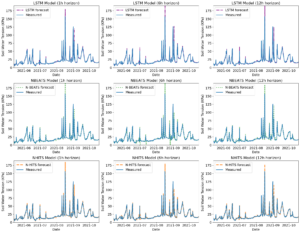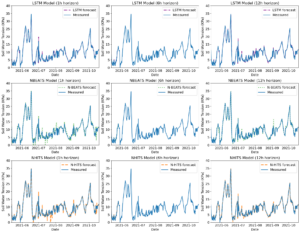Final report for GS22-259
Project Information
The interaction between human-engineered systems (e.g., irrigation) and natural processes needs to be modelled explicitly with an approach that can intelligently quantify the influence of incomplete/ambiguous information on decision-making processes. New developments in machine learning (ML) and artificial intelligence (AI) techniques hold great potential to unlock the value of big data for precision irrigation technology development. By directing our research on Increasing Sustainability of Existing Farming Practices, Appropriate Technology and Natural Resources/ Conservation/ Water Quality, we sought to advance the technology and innovative research needed to understand and develop systems that can sense, learn, and act in the agricultural environment. This research leveraged existing data to pilot the development of a novel ML technique to support the next generation of irrigation decision support systems. Our proposed approach was to estimate the daily irrigation needs of a field irrigated by a center pivot, based on soil moisture measurements and climatic variables using Deep Reinforcement Learning (DRL) as a type of ML technique that enables an intelligent agent to learn in an interactive environment by trial and error using feedback from its past actions and experiences. Fieldwork activities for this research were carried out at Clemson University's Edisto Research and Education Centre (REC) near Blackville, SC. The collected data were used to develop the proposed irrigation decision support system.
Focusing at the interface of three SARE focus areas, i.e., Increasing Sustainability of Existing Farming Practices, Appropriate Technology and Natural Resources/ Conservation/ Water Quality, PRECISION project had two main objectives: (i) Develop an intelligent irrigation decision support system that has the potential to benefit precision irrigation and rule-based irrigation scheduling, (ii) Provide irrigation decisions that can add value to farm profitability and irrigation management.
A 7-acre field irrigated by a center pivot located at Clemson’s Edisto REC, near Blackville, SC, was used as the demonstration site for this effort. The DRL-based irrigation scheduling software is directly applicable to farms whose climate and soil conditions are identical to this study area. However, before its application in irrigated areas with different climate and soil characteristics, the tool's effectiveness will have to be checked by evaluating its performance with respect to irrigation water use efficiency and yield production. For that reason, further research on how the tool can be used to optimize water use for other crops and field conditions will be required.
Research
This project proposed a program of three major work tasks (WTs), designed to focus on the mission of the SARE program. These WTs and accomplished activities are described in detail below.
WT1: a. Field data Collection and Pre-processing.
Data from field experiments conducted with two farmers in the 2020, 2021 and 2022 growing seasons consisting of sensor-measured soil moisture, crop yield and weather data from NOAA stations were obtained. Additional weather and soil moisture data were collected during the 2023 and 2024 growing seasons at Clemson’s Edisto REC. These data were pre-processed to identify outliers and missing values and to perform quality checks before incorporating them into the models. Pre-processed data were stored in open-source platforms such as GitHub to ensure free and easy access to irrigation research communities.
b. Conducting surveys to understand adopted irrigation practices to optimize water use
A survey was conducted to understand the irrigation practices of farmers, specifically the criteria based on which they schedule irrigation. The survey responses were analyzed to produce a reward function serving as the objective function in the DRL algorithms. The information from the survey was useful in:
- Understanding the farming practices: We have gathered information about the current farming practices employed by farmers, including their irrigation strategies, crop management techniques, and factors influencing the irrigation decision-making
- Identifying key objectives and trade-offs: The survey has helped elicit farmers’ preferences, such as maximizing crop yield or minimizing water usage, and understand trade-offs that farmers face in decision-making, such as balancing water use efficiency with yield potential.
- Assessing the economic consideration: We collected information on the cost of irrigation, and revenue from harvest sold in the past growing seasons. This information was essential for designing a reward function that reflected the financial implications of irrigation decisions and aimed to maximize net returns.
- Validating model parameters: The survey provided an opportunity to validate assumptions made in the RL model and gather data to parameterize the model. For example, the information on the irrigation cost and yield in the past seasons was used to parameterize Equation 1, which was used as the objective/ reward function of the model.
Net return on water = yield (kg/ha) * price of product (dollars/kg) – water use (ha-mm/ha) * price of water (dollars/mm) (Equation 1)
WT2: Pilot the development of DRL Algorithms. Current state-of-the-art irrigation decision support tools combine predictive process-based crop models with soil moisture data (pre-defined triggers) to schedule irrigation during the growing season. We proposed to enhance and automate these traditional methods by developing DRL algorithms such as Deep Q-Learning (DQL) and Double Deep Q-Learning (DDQL) as semi-supervised learning models to optimize irrigation efficiency. DRL is a framework where intelligent agents learn to perform actions in an environment to maximize a reward. The two main components of DRL system are the environment (cotton farm), which represents the irrigation scheduling problem to be solved, and the agent, which represents the DRL learning algorithm.
The process of developing the irrigation DSS started with setting up and creating soil moisture forecasting models that can estimate the status of soil moisture fluctuations across the depth from 1h to 12h ahead using novel machine learning algorithms known as Neural Hierarchical Interpolation for Time Series Forecasting (NHITS) and Neural Basis Expansion Analysis for Time Series (NBEATS) and Long Short Term Memory (LSTM) as a benchmark model for fields located in Blackville, SC and at the University of Georgia’s Stripling Irrigation Research Park (SIRP) situated near Camilla, Georgia. These predictions were used for planning irrigation scheduling with DRL algorithms using current and forecasted soil moisture and weather data to optimize water use.
WT3: Extension and Outreach, and Results Dissemination.
As part of result dissemination, one publication (Umutoni & Samadi, 2024), one book chapter in press and eight conference presentations have resulted from this research. Additional outreach programs included attending farmers’ field days in 2023 and 2024 as an opportunity for direct and effective communication between farmers and the research group and to get farmers’ responses on the survey.
Obtained results showed that NHITS and NBEATS models can accurately estimate soil moisture fluctuations at 6 in and 12 in of soil depth, as illustrated by Figure 1 and Figure 2 comparing measured and forecasted soil water tension at different time horizons. Used error metrics also showed excellent model performance where the Nash Sutcliffe Efficiency (NSE) for all three models is above 0.9.


Educational & Outreach Activities
Participation Summary:
This project was about developing machine learning tools to predict irrigation needs. The machine learning tools were trained with data collected from the field to predict soil moisture fluctuations across the soil depth. Multiple algorithms were tested to understand the soil moisture change in time and variables influencing this change and guide irrigation scheduling. Eight oral presentations have been given at national and international conferences namely the American Geophysical Union, the European Geophysical Union, the SC Water Resources conference and the American Society of Agricultural and Biological Engineers annual conference. One paper was published, one book chapter is in press while another paper is in preparation.
The published paper "Umutoni, L., & Samadi, V. (2024). Application of machine learning approaches in supporting irrigation decision making: A review. Agricultural Water Management, 294. https://doi.org/10.1016/j.agwat.2024.108710" is shared in the Information products section of this report.
Project Outcomes
The outcomes achieved by this project can help farmers in three ways:
- Estimating crop yield helps farmers plan ahead for equipment needs, labor, and fuel requirements, cash-flow budgeting, etc.
- Forecasting crop yield is also useful for analyzing weather-related variability to guide decisions such as irrigation scheduling and crop management.
- Promoting sustainable irrigation water management practices to increase crop yield begins with accurately predicting soil water dynamics in the root zone. Therefore, skillful soil moisture prediction is essential to bridge the gap between irrigation water demand and availability.
During the course of the project, the research team had the opportunity to collaborate and interact with farmers, which enabled us to collect primary data/information on irrigation practices and challenges faced in irrigation planning and scheduling that hinder the sustainable use of available water resources. Additionally, the grant supported field experiment activities that broadened our understanding of challenges encountered during irrigation, such as system failures, low equipment efficiencies, etc., which guided us in designing a system that is not just theoretically efficient but also technically practical.
N/A